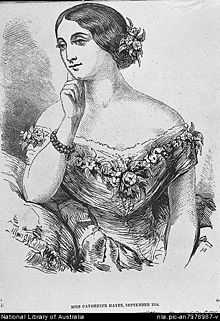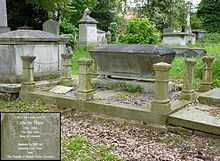Catherine Hayes (soprano)
| Catherine Hayes | |
|---|---|
 Miss Catherine Hayes, September 1854, by George W. Mason | |
| Born |
1818? Limerick City, Ireland |
| Died | 11 August 1861 |
| Occupation | Opera soprano |
Catherine Hayes, married name Catherine Bushnell, (1818? – 11 August 1861)[n 1] was a world-famous Irish soprano of the Victorian era.[1] According to London's Daily Express, "Hayes was the 'Madonna' of her day; she was the 19th-century operatic equivalent of the world's most famous pop star."[n 2]
Youth in Limerick and education in Dublin and Paris (1818–1845)
Hayes was baptized on 8 November 1818.[1] She was born of humble Anglo-Irish parentage at 4 Patrick Street, Limerick.[3] Her father was the musician Arthur Williamson Hayes;[1] he abandoned the family,[2] and young Kate Hayes grew up very poor with her mother and sister.[1][2]
In 1838, her vocal talents attracted the notice of Edmund Knox, the Church of Ireland bishop of Limerick.[1][3] She then gave private performances for the local Protestant Ascendancy.[1]
Through Bishop Knox's exertions, funds were procured to enable Hayes to study in Dublin under Antonio Sapio, from 1 April 1839 until August 1842.[3] Her first appearance took place on 3 May 1839 at Sapio's annual concert in the charitable fundraising theatre at the Rotunda Hospital in Dublin (now the Gate Theatre).[3] Early next year she sang in her native Limerick, and then frequently in Dublin, and soon raised her terms to ten guineas a concert.[3] After hearing Grisi and Mario in Norma on 13 Sept. 1841, she decided to come out on the lyric stage, and, going to Paris on 12 Oct. 1842, studied under Manuel Garcia, who after a tuition of a year and a half advised her to proceed to Italy.[3]
Further education and early performances in Milan, Marseilles, Vienna, and Venice (1845–1848)
At Milan she became the pupil of Felice Ronconi,[n 3] and through the intervention of Giuseppina Grassini was engaged for the Italian Opera House, Marseilles, where on 10 May 1846 she made her first appearance on the stage as Elvira in I puritani and was enthusiastically applauded.[3]
After her return to Milan she continued her studies under Ronconi, until Morelli, the director of La Scala at Milan, offered her an engagement.[3] Here her first character was Linda, and she was recalled twelve times by the audience.[3] Her voice had now become a soprano of the sweetest quality, and of good compass, ascending with ease to D in alt.[3] The upper notes were limpid, and like a well-tuned silver bell up to A.[3] Her lower tones were the most beautiful ever heard in a real soprano, and her trill was remarkably good.[3] She was a touching actress in all her standard parts. She was tall, with a fine figure, and graceful in her movements.[3] Shortly after Hayes' performance at La Scala, Giuseppe Verdi became interested in her for one of his new operas.[2]
She remained at Milan during the autumn of 1845 and the carnival of 1846, and took the characters of Lucia di Lammermoor (in which part she became the most sought-after performer of the age),[2] Zora in Mosè in Egitto, Desdemona, and Amina.[3] Later on in 1846 she sang in Vienna, and on the first night of the carnival of 1847 appeared in Venice in a poor opera composed for her by Malespino, a nobleman, entitled Albergo di Romano.[3] Returning to Vienna, she took part in Estella di Murcia, expressly written for her in 1846 by Federico Ricci.[3]
Mature performing career

Performances in London, Dublin, and Rome (1849–1851)
After a tour of the Italian cities, Hayes returned to England in 1849, when Delafield engaged her for the season at a salary of £1,300.[3] On 10 April she made her début at Covent Garden in Linda di Chamounix, and was received with much warmth.[3]
At the close of the season, in June 1849, she sang before Queen Victoria at Buckingham Palace.[2] "After an evening of Italian music, the Queen requested an encore. Catherine, with a mischievous grin it is reported, sang the beautiful Irish rebellion song, Kathleen Mavourneen."[2]
On 5 Nov. 1849 she appeared at a concert given by the Dublin Philharmonic Society, and afterwards at the Theatre Royal, Dublin, in Lucia, when the Edgardo was so badly played that an uproar ensued, and Sims Reeves, one of the audience, took his place on the stage.[3]
Under Lumley's management Miss Hayes played Lucia at Her Majesty's Theatre, London, on 2 April 1850, but owing to ill health and other causes she was seldom seen during the remainder of the season.[3]
At the carnival in Rome in 1851 she was engaged at the Teatro d'Apollone, and performed in Maria de Rohan for twelve nights, and received the diploma of the Academia di Santa Cecilia.[3] From Rome she returned to London, where during the season of 1851 she was the star of the concert-room and of the performances of the Sacred Harmonic Society, singing in the oratorios of Handel, Haydn, and Mendelssohn.[3]
Performances in the Americas (1851–1853)
Leaving England in September 1851, and first singing in New York on the 23rd of that month, she there, by the advice of William Avery Bushnell of Connecticut, an electioneering agent and former manager for the "Swedish Nightingale," Jenny Lind,[2] forfeited £3,000, and gave Bushnell the management of her tour.[3] Hayes also performed in Boston, Toronto, Philadelphia, Washington D.C., Charleston, Savannah, New Orleans, and forty-five other locations including the river towns along the Mississippi.[2] Hayes "met presidents, statesmen and business leaders along the way."[2]
P.T. Barnum sponsored Hayes' tour of California, where she was billed as "The Swan of Erin", and "The Hibernian Prima Donna".[2] She sang "at San Francisco from November 1852 to May 1853, where her fees averaged £650 a month; the 'semi-civilised' gold miners bidding up to £1150 to hear her sing."[1]
The newspaper Far West News wrote of her debut at San Francisco's American Theater in 1852 that "[l]ong and loud were the cheers and applause, which greeted her entrée ... She acknowledged again and again the enthusiastic testimonial, and again and again the audience cheered and applauded ... It was while standing at the foot-lights, amid the storm of applause, that our citizens had the first view of Miss Catherine Hayes ... Miss Hayes is about thirty years of age. She is a graceful, queen-like person, of medium stature, with a fair oval face. Her features are regular, hair bright auburn, eyes blue, and her face wears an intellectual expression without much animation. She dresses with taste, and her manner is perfectly easy and self-possessed; her gesticulation appropriate and graceful."[2]
During the spring of 1853, Hayes toured the California Gold Country.[2] She "was a visitor to many mining camps, and even tried her hand at gold panning."[2] The Nevada Journal newspaper of Nevada County, California wrote of her performance at the Alta Theater in Grass Valley, California on April 18, 1853 that Hayes' voice "broke forth in notes of most bewitching sweetness and harmony. The excitement of the audience increased to a furious extent, no doubt with proud ratification that they had heard for once in their lives, the voice that had awakened the admiration of the western world.”[2] Kate Hayes Street in Grass Valley is named for Hayes.[2]
Hayes departed California for South America, and after visiting the principal cities (including Lima, Valparaiso, and Santiago) embarked for Australia.[3]
Performances in Oceania and Asia (1854–1856)
She gave concerts in the Sandwich Islands (present-day Hawaiian Islands), and arrived at Sydney in January 1854.[3] Her arrival in Sydney caused "an excitement wholly unparalleled in the theatrical annals of this colony."[1] Her performance at the Victoria Theatre[n 4] on 3 October 1854 was enthusiastically received; in addition to her operatic performance, Sydney audiences very much appreciated her performances of ballads like "Home, Sweet Home" and "Oh, Steer My Bark to Erin's Isle."[1] At a thronged 18 October 1854 sendoff for Hayes at Sydney's Circular Quay, Judge Sir Roger Therry declared that Hayes would be recalled by Sydneysiders with "admiration, respect, and esteem.".[1] Hayes donated the proceeds of her final concert in Sydney to the Destitute Children's Asylum.[1]
The Age newspaper called Hayes' first concert in the Queen's Theatre,[n 5] Melbourne, "a great event in our local history." After a tour through Geelong and Adelaide, she departed for Calcutta, where she disembarked in January 1855[1] and performed for the British colonial military there.[2] Due to the poor economic situation in Calcutta,[1] she left for Batavia (present-day Jakarta)[3] and Singapore[2] before returning to Australia, where she performed again in Sydney and Melbourne.[1][3]
Later life (1856–1861)

She returned to England in August 1856, after an absence of five years.[3] That year, she lost $27,000 by the failure of Saunders & Brennon of San Francisco.[3]
On 8 October 1857, at St. George's, Hanover Square, she married William Avery Bushnell.[3] He soon fell into ill-health, and died at Biarritz, France, on 2 July 1858, aged 35.[3] She appeared at Jullien's promenade concerts at Her Majesty's Theatre in 1857, when her ballad singing, the branch of art in which lay her greatest power, was much applauded.[3] After her husband's death she took part in concerts in London and the country towns.[3]
She died in the house of a friend, Henry Lee, at Roccles, Upper Sydenham, Kent, on 11 August 1861, and was buried in Kensal Green Cemetery on 17 August.[3] Her will was proved on 26 August, the personalty being sworn under £16,000.[3]
Notes
- ↑ Boase, writing in 1891, gives Hayes' date of birth as 29 October 1825; however, the 1885–1900 Dictionary of National Biography is well-known for inaccuracies. Shoesmith, writing in 1972, notes in the Australian Dictionary of Biography that Hayes was baptized on 8 November 1818; this confirms Hayes was alive 7 years before 1825, and strongly suggests she was born in 1818.
- ↑ Quoted in Noy.[2]
- ↑ Son of the tenor Domenico Ronconi
- ↑ Not to be confused with the many other halls called the Royal Victoria Theatre, the Royal Victoria in Sydney was founded in 1838, and burnt down in 1880.
- ↑ Opened in 1845, the Queen's Theatre, Melbourne, was demolished in 1922.
References
- ↑ 1.0 1.1 1.2 1.3 1.4 1.5 1.6 1.7 1.8 1.9 1.10 1.11 1.12 1.13 Shoesmith, Dennis (1972). "Hayes, Catherine (?–1861)". Australian Dictionary of Biography. Canberra: Australian National University. Retrieved 18 April 2014.
- ↑ 2.0 2.1 2.2 2.3 2.4 2.5 2.6 2.7 2.8 2.9 2.10 2.11 2.12 2.13 2.14 2.15 2.16 2.17 Noy, Gary (Fall 2008). "The Swan of Erin: The Enduring Legacy of Kate Hayes". Snowy Range Reflections: A Journal of Sierra Nevada History and Biography (Sierra College Press) 1 (3). Retrieved 18 April 2014.
- ↑ 3.0 3.1 3.2 3.3 3.4 3.5 3.6 3.7 3.8 3.9 3.10 3.11 3.12 3.13 3.14 3.15 3.16 3.17 3.18 3.19 3.20 3.21 3.22 3.23 3.24 3.25 3.26 3.27 3.28 3.29 3.30 3.31 3.32 3.33 3.34
 Boase, George Clement (1891). "Hayes, Catherine". In Stephen, Leslie; Lee, Sidney. Dictionary of National Biography 25. London: Smith, Elder & Co. pp. 288–89.
Boase, George Clement (1891). "Hayes, Catherine". In Stephen, Leslie; Lee, Sidney. Dictionary of National Biography 25. London: Smith, Elder & Co. pp. 288–89.
Sources
- Walsh, Basil (27 July 2000). Catherine Hayes: The Hibernian Prima Donna. Irish Academic Press. ISBN 978-0716526629.
 This article incorporates text from a publication now in the public domain: Boase, George Clement (1891). "Hayes, Catherine". In Stephen, Leslie; Lee, Sidney. Dictionary of National Biography 25. London: Smith, Elder & Co. pp. 288–89.
This article incorporates text from a publication now in the public domain: Boase, George Clement (1891). "Hayes, Catherine". In Stephen, Leslie; Lee, Sidney. Dictionary of National Biography 25. London: Smith, Elder & Co. pp. 288–89.
External links
 Media related to Catherine Hayes at Wikimedia Commons
Media related to Catherine Hayes at Wikimedia Commons